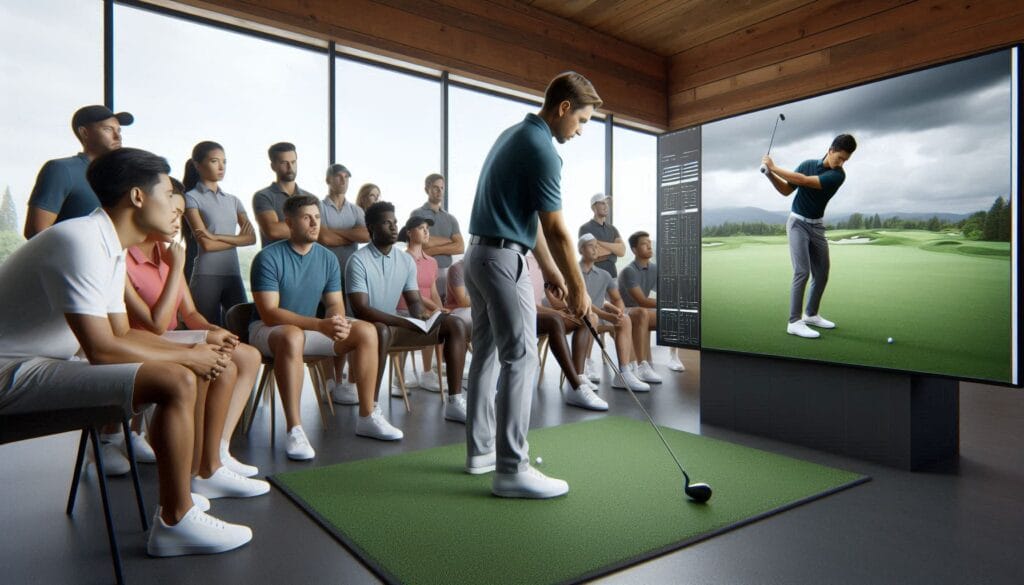Top Takeaways and Key Concepts
Please Note: This post may contain affiliate links. If you click one of them, we may receive a commission at no extra cost to you. As an Amazon Associate, I earn from qualifying purchases.
→ Perfect your grip and stance to create a balanced, consistent foundation for every swing.
→ Refine your rhythm and timing through slow-motion swings or music to build smoother motion.
→ Record and review your swing to identify hidden flaws and track visible improvement over time.
→ Incorporate creative practice drills that keep sessions engaging while improving accuracy and control.
→ Strengthen your mental focus using mindfulness and visualization to boost confidence before each shot.
Summary of This Article
This article teaches golfers how to improve swing performance through proper grip, timing, and mindset. It highlights using video feedback, creative drills, and mental focus to enhance accuracy and rhythm. By combining smart practice with mindfulness, players can develop smoother, more consistent swings and enjoy the game with greater confidence and control.
Video Summary
Golf requires skill, patience, and sometimes a little bit of luck, like when you discover your ball in the bushes instead of the water hazard. But let's be honest: the most important thing you can do to lower your score is to improve your golf swing. This article is for you whether you're a beginner who doesn't know which end of the club to grasp or an experienced player who wants to polish that lovely arc. So get your favorite clubs and let's go over some tips that could make you the next golf star (or at least help you avoid those awful double bogeys).
Understanding the Basics of a Good Swing

“Golf is like marriage; if you take yourself too seriously, it won't work.” — Jack Nicklaus
You need to know what makes a good swing work before you can improve your golf swing. Everything begins with grip and stance. To be honest, if you don't know how to do these things perfectly, it's like trying to bake cookies without understanding how to weigh flour. You can end up with something cool but not quite right!
The grip should be firm but not too tight. Think about holding an ice cream cone. You want to apply just the right amount of pressure so it doesn't slip away but not so much that it breaks! For stance, think about how hard it is to balance a book on your head while standing on one leg. It's hard, but it's necessary for stability.

Now, once you've got that down, it’s time to focus on your backswing. This is where most golfers tend to go off track. You know how sometimes you get a little too excited about something and end up tripping over your own feet? Well, the same can happen with your golf swing! A proper backswing sets up everything else in your shot, almost like laying the foundation for a house. If that foundation is shaky, good luck keeping the roof from caving in!
Picture yourself winding up like a rubber band before letting go; if you're too tight or too loose, things can get messy real quick! When you take that club back, it should feel fluid and controlled—like a gentle wave rolling into shore rather than a tsunami crashing down. As you begin your backswing, think about rotating your shoulders while keeping your lower body steady. It’s all about creating torque without losing balance.
Now let’s talk about the length of the backswing. Too short? You might not generate enough power. Too long? Well, hello there, Mr. Wild Slice! Ideally, you want to bring the club back until your left arm (for right-handed golfers) is parallel to the ground while maintaining that nice relaxed grip we talked about earlier. It's like reaching for the cookie jar on a high shelf—stretch just enough to grab what you want without tipping over!
Did you know that the average golfer swings their club about 70 times per round? That’s roughly equivalent to doing a mini workout! So next time you're on the course, remember: you're not just playing golf; you're also getting your daily cardio—just don’t be surprised if your muscles feel like they’ve been through a blender afterward! Who knew perfecting your swing could double as an unexpected fitness regime?
Don’t forget to keep an eye on your head position during this phase. Many golfers have a tendency to lift their heads prematurely as they start their downswing—it's kind of like trying to peek at what’s happening during a magic trick before it’s finished! Keeping your head still allows for better accuracy and helps maintain alignment throughout the entire swing.
Practice makes perfect! Spend some time focusing solely on perfecting that backswing without worrying about hitting balls initially. Grab an old club or even just practice swinging with no ball at all; feel free to exaggerate those movements until they become second nature. In no time at all, you'll be well on your way to refining not only your backswing but also elevating every aspect of your golf game!
The Importance of Rhythm and Timing
“You swing your best when you have the fewest things to think about.” — Bobby Jones
When it comes to getting better at your swing, time and rhythm are really important. Have you ever seen someone dance badly at a wedding? That's what happens when you don't have a beat! You want your swing to go smoothly from the beginning to the end.
I suppose that practicing slow-motion swings is one method to get this rhythm down. Really! It might sound funny, but pretending to swing through molasses might help you create muscle memory without hurrying through each move. Once you have the smooth motion down in slow motion, speed it up little by little until it seems right.
A lot of professionals say that music can help you keep time while you practice, which is interesting. It might seem a little strange—golf is usually thought of as a silent sport where the only sounds are the faint thud of your club hitting the ball and maybe the occasional “fore!” echoing over the green. But here's the kicker: selecting songs with a constant beat and matching your swings to that beat can really change how you play! Who would have thought that playing music could help your golf game?

Imagine this: you put on your headphones, walk to the driving range, and get ready to hit some big swings. A decent playlist can make you feel better and make a monotonous practice more fun. Think about it! You dance to your favorite music instead of counting down to each swing or continuously checking your form. The beat helps you create a natural rhythm that matches the speed of your swing perfectly.
But you need tunes with a solid pace. You don't want to dance in the middle of a swing (trust me, that's not a good idea!). Many people think that songs with 120 to 140 beats per minute are fantastic because they sound like the tempo of a good golf swing. So, if you're listening to old rock or pop songs to get pumped up, pay attention to how the beats make you move.
It's time to get to work! Notice how your focus changes as you practice swinging to these beats. You might not care as much about taking gorgeous pictures and more about having fun with the process. It's really crucial that you adjust your mind since golf is as much about your mind as it is about your body. Also, you're more inclined to practice more when you're having fun, and we all know that spending more time on the course makes you play better!
Ever noticed how some golfers look like they're dancing when they swing? Well, it turns out that having a good rhythm in your golf swing can actually be the secret to success—just ask any golfer who's ever tried to hit a shot after listening to “Eye of the Tiger” on repeat! Legend has it that if you get your timing right, not only will you hit the ball farther, but you might also end up with an impromptu dance-off with your caddy. So remember: it's all about finding your groove—just don’t break out into the Macarena on the tee box!
Another interesting benefit? Music can help drown out distractions around you—like that guy who insists on talking loudly about his last round while you're trying to concentrate (you know who I’m talking about). With good tunes blasting in your ears, it's easier to zone in on what matters: your swing and how it feels.
So next time you're heading out for some practice swings, don’t forget to load up that playlist! Embrace the idea of becoming one with both rhythm and golf; after all, refining your swing doesn’t have to be boring! Whether you're belting out lyrics under your breath or simply swaying along while focusing on technique, remember: sometimes shaking things up—even if it means dancing like nobody's watching—can lead to remarkable improvements on the green!
Video Analysis: Seeing Is Believing

“I love playing golf with my friends. It’s a great way to spend time together—especially when I’m winning!” — Phil Mickelson
Have you ever seen yourself on camera and thought, “Wow, I didn't know I looked like that”? When you're working on your swing, video analysis can really open your eyes! When you record yourself hitting balls, you may see what other people see (and maybe cringe at how silly your face looks).
When you watch the video, pay attention to both your body mechanics and your posture at each part of the swing. Are you leaning too far back? Is there too much swaying? These small things are what make the difference in getting things to be consistent.
You might even ask friends or teachers for their thoughts after you share videos of your swings. I mean, let's be honest: when you're out on the course, you could feel like you're a pro golfer. But what about when you see yourself on video? That's a whole other story! It's remarkable how those minor idiosyncrasies and eccentricities get into our swings without our even knowing it. That crazy chicken dance move you execute in the middle of a swing, for example, is generally not going to assist your game!
Recording your practice sessions gives you a wealth of information. You can see things you might have missed in the heat of the moment by watching yourself swing. Your grip can be a little wrong, or your stance might look more like you're attempting to balance on one leg than ready to act. These are small things that can have a big effect on how well you do.
You might have some interesting conversations if you show these movies to your friends or teachers. Friends often make things more fun and humorous. After all, who doesn't want to poke fun at themselves? They could say, “Your follow-through looks more like an awkward dance move than a smooth finish.” And to be honest, it's funny now, but this kind of constructive criticism could truly help you get better.
Because teachers have seen a lot of golfers, they know what works and what doesn't, so they take a more technical approach. They can see problems with form and technique that we wouldn't even think of. When they tell you to modify things based on what they observe in your video, they're not just being picky; they're helping you improve your skill and keep it up.
It's interesting because feedback isn't only about finding faults; it's also about celebrating successes! Your pals might suggest that you've gotten a lot better since last season or that you can now make that hard chip shot every time. People stay motivated when they hear good things about themselves.
Did you know that some golfers are so dedicated to perfecting their swing that they’ve started using video analysis to compare their shots to those of pro players? One golfer even went viral for analyzing his swing against a famous player and accidentally discovered he was more in sync with the player's celebratory dance moves than the actual swing! Now, instead of just improving his game, he's known as “The Dancing Golfer” at his local course—proving once and for all that sometimes it’s not just about seeing your swing; it's also about seeing if you can bust a move while doing it!
And don't forget how important it is to be open-minded when you get critique. When someone points out something less-than-glamorous about our swing (like the chicken dance), it can hurt a little. But if we want to do better at what we do, we need to be open to constructive criticism.
So the next time you're at the range, take your smartphone with you! Don't be afraid to share those swings with others; they could help you learn a lot about your game! You never know; those small changes that friends or teachers recommend might be just what you need to make your golf game jump from “meh” to “wow!” Every golfer can get better, and sometimes it helps to view ourselves through someone else's eyes (or camera lens) to really comprehend where we are on our way to becoming a master!
Drills That Make Sense (And Some That Don’t)
“The ball is not going to move until you hit it.” — Lee Trevino
Let’s talk drills because they’re essential for honing skills—and yes, some are more entertaining than others! One drill I find helpful involves placing tees around 6 inches apart along an imaginary line where you'd ideally hit the ball consistently.
Start swinging at these tees without hitting them—this encourages accuracy while maintaining proper form since you'll be focused on avoiding contact with those pesky little markers!
Did you know that one golfer once created a drill to improve his putting by using a rubber chicken as a target? He figured if he could sink a putt while aiming at something so ridiculous, he'd have no problem with the actual hole! His friends thought it was absurd until they saw him consistently making long putts while everyone else struggled. Now, every time he steps onto the green, people ask if he's brought his “lucky poultry,” proving that sometimes the most nonsensical drills can lead to surprisingly effective results—just don’t be surprised if your ball ends up in the wrong kind of fowl play!
Another fun drill involves using alignment sticks or even pool noodles placed on either side of where you'd normally stand during shots—this creates barriers forcing better positioning while making practice feel like an obstacle course!
But hey—not every drill needs serious finesse; sometimes just whacking balls at targets works wonders too! Find creative ways that keep practice enjoyable rather than monotonous.
Finding Professional Help
“I have a tip that can take five strokes off anyone's game: It's called an eraser.” — Arnold Palmer
Sometimes we all need an extra set of eyes—or maybe two—to refine our swings effectively. Seeking professional help can seem intimidating (especially if they look like they just walked off a PGA Tour), but honestly? They’re there for YOUR improvement!
A skilled instructor will analyze everything from grip strength down through follow-throughs while providing personalized advice tailored specifically for YOU—not some cookie-cutter approach everyone else gets stuck with!
Plus—and this is important—they'll often have access to technology designed specifically for analyzing swings—which means more accurate feedback than any old friend who thinks they know best because they've played longer than you have!
Mental Game: Focus and Confidence
“The secret is in the dirt.” — Ben Hogan
Last but not least, we need to work on the mental side of improving our golf swing. After all, the mind plays tricks on us faster than my cat sneaks onto my keyboard during business calls!
Positive visualization techniques can help you feel more confident when you go up to the tee box or green. It's like believing you're in an action movie where every shot counts toward saving the world or at least beating your pals!
Mindfulness exercises can also help you get rid of distractions before you take those key shots. You know how it is: you're on the tee, holding your club, when all of a sudden your mind starts to race. Did I forget to turn off the oven? What's for supper? Did I remember to text my friend about the next game? It's like trying to concentrate while a band plays in your head. That's when mindfulness comes in.
Let me tell you, deep breathing isn't simply something you learn in yoga class; it can affect the way you play golf. Take a deep breath before you let your power loose on all the unfortunate golf balls. Breathe in through your nose and let the air fill your lungs like you're attempting to blow up a balloon. Just hold it for a second and feel the tension start to go away. Then gently breathe out through your mouth, as if you're letting out all the stress from a long week at work. Ahh, sweet freedom!
It's remarkable how much clearer everything gets when you exercise this kind of awareness before each shoot. All of a sudden, those annoying thoughts about what happened earlier in the day or fears about missing that key putt vanish into the background noise. Instead, you become very focused on what really matters: your swing and the ball sitting on the tee, waiting for its fate.
A lot of golfers say that adding mindfulness to their practice helps them find a rhythm, both in their swings and in their own lives. It's like making a soundtrack in your head where every breath counts down to the ideal time when you hit the ball. And who doesn't want to feel like they're dancing gracefully through their golf game instead of tripping over every step?
Being mindful might also make the game more fun for you. When you are fully present in each moment, whether you are enjoying the beauty of nature around you or spending time with friends, the experience becomes so much better. It's not just about hitting par in golf; it's also about enjoying being outside and getting to know other people.
Did you know that one pro golfer swears by his “lucky underwear” for confidence on the course? He claims that every time he wears them, he plays like a champion. The catch? They’re bright pink with cartoon ducks all over! His friends joke that it’s not just about focus and confidence but also about making sure the competition is too busy laughing to play well. So next time you're struggling with your mental game, remember: if a pair of goofy undies can boost a golfer's self-esteem, maybe it's time to embrace your own quirky rituals—just be careful where you drop your pants on the 18th hole!
Here's a tip: before you go out on the course, make it a habit to do some short mindfulness exercises. You may see yourself making perfect shots or do some light stretches while only thinking about how amazing it feels to move freely again after sitting at a desk all day.
When you stand over that ball and get ready to swing, this sense of serenity will not only help you focus, but it might also help you play better overall! So the next time someone asks why you seem so calm before you tee off, just smile and explain, “It's all part of improving my inner golfer, one mindful breath at a time!”
So, once again, focusing equally on both your physical technique and your mental strength will eventually lead to steady progress over time.
Featured Snippet: Improving your golf swing starts with a balanced grip, smooth rhythm, and focused mindset. Combine steady practice, video feedback, and creative drills to refine technique, accuracy, and confidence. With patience and consistency, every golfer can develop a swing that’s powerful, controlled, and repeatable.
Frequently Asked Questions
What’s the most important part of a good golf swing?
The grip and stance form the foundation of a great swing. A relaxed, balanced setup improves control, consistency, and overall performance on every shot.
How can I improve my rhythm and timing in golf?
Practice slow, steady swings to build muscle memory. You can also use music or a metronome to develop smoother tempo and better timing.
Why should I record my golf swing on video?
Video feedback helps identify small flaws in posture, alignment, and motion that you might not notice in real time. It’s a simple way to track progress and refine technique.
What are some effective golf drills for accuracy?
Try alignment stick drills or short swing repetitions to strengthen consistency. Creative exercises make practice engaging while improving balance and precision.
When should I consider professional golf instruction?
If your progress stalls or you struggle with consistency, a coach can analyze your mechanics and provide tailored feedback for faster improvement.
How does mindfulness help my golf game?
Mindfulness and visualization reduce stress, sharpen focus, and improve decision-making during play. Breathing exercises before each shot enhance calm and control.
How often should I practice to see real improvement?
Practicing three to four times weekly—focusing on quality, not just quantity—helps build muscle memory and confidence faster than infrequent, unfocused sessions.
Suggested Resources:
How To Improve Your Golf Swing
https://www.golfdigest.com/story/how-to-improve-your-golf-swing
The Science Behind the Perfect Golf Swing
https://www.golf.com/instruction/2021/06/15/science-perfect-golf-swing/
10 Drills to Perfect Your Golf Swing
https://www.golfmonthly.com/advice/drills/perfect-your-golf-swing-drills-203338

Kevin Collier is an avid golfer and contributing author at AIGolfTips.com, where he shares his passion for the game through expert tips, techniques, and gear reviews. With years of experience on the course, Kevin offers valuable insights for golfers of all skill levels, helping them improve their game and maximize their potential. Whether discussing swing mechanics or the latest in golf technology, Kevin's engaging approach aims to inspire and educate fellow golf enthusiasts to elevate their performance and enjoy every moment on the green.





